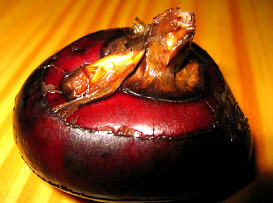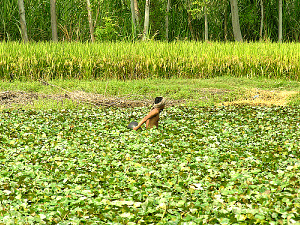 The Chinese water chestnut (Eleocharis dulcis), more often called simply the water chestnut, is a grass-like sedge cultivated for its edible root. The water chestnut is actually not a nut at all, but an aquatic vegetable that grows in marshes, underwater in the mud. It has tube-shaped, leafless green stems that grow to about 1.5 meters. The small, rounded corms have a crispy white flesh and can be eaten raw, slightly boiled, grilled, pickled, or tinned. They are a popular ingredient in Chinese dishes.
The Chinese water chestnut (Eleocharis dulcis), more often called simply the water chestnut, is a grass-like sedge cultivated for its edible root. The water chestnut is actually not a nut at all, but an aquatic vegetable that grows in marshes, underwater in the mud. It has tube-shaped, leafless green stems that grow to about 1.5 meters. The small, rounded corms have a crispy white flesh and can be eaten raw, slightly boiled, grilled, pickled, or tinned. They are a popular ingredient in Chinese dishes.
In China, they are most often eaten raw, sometimes sweetened. They can also be ground into a flour form used for making water chestnut cake, which is common as part of dim sum cuisine. They are unusual among vegetables for remaining crisp even after being cooked or canned, because their cell walls are cross-linked and strengthened by certain phenolic compounds.
The corms are rich in carbohydrates, and are also a good source of dietary fiber, riboflavin, vitamin B6, potassium, copper, and manganese.
Raw water chestnuts are slightly sweet and very crunchy. Boiled water chestnuts have a firm, and slightly crunchy texture, with a flavor that is very mild, slightly nutty in taste, so it is easily overpowered by any seasonings or sauces the water chestnut is served or cooked with. Water chestnut are often combined with bamboo shoots, cilantro, ginger, sesame oil and snow peas. It is often used in pasta or rice dishes.
Many Western consumers are only familiar with canned water chestnuts. Fresh water chestnuts, when they are available, are a completely different experience. The crunchy texture may be similar in both, but fresh water chestnuts are sweeter, with layers of flavor which are obscured during the canning process. The flesh of the vegetable also has a slightly different texture, with fresh water chestnuts being more brittle and prone to shattering, rather than slightly slimy like their canned cousins. Water chestnuts can also be found in pickled form at some markets, and the flesh is sometimes ground to make flour. The flour can be somewhat expensive, but it is well suited to certain Asian dishes.
When selecting fresh water chestnuts, if they are available, look for plump specimens without any sign of wrinkling. The outer skin should be dark brown and lustrous, and when cut open, the water chestnuts will be bright white. Fresh water chestnuts can be stored under refrigeration in water for up to one week before use. Canned water chestnuts can be kept in a cool dry place until they are opened, after which they should be rinsed and used within a few days.
How to grow Chinese Water Chesnut or Apulid
Problems with Growing the Crop
Chinese water chestnuts are a potential small crop for specialized markets for growers in warm temperate regions. However, they can only be grown in limited areas where the specific water requirements can be provided. Chinese water chestnuts need to be completely submerged with a controlled level of water for most of the life of the crop (similar to paddy rice) and it is preferable to drain the water for harvesting. The purchase of tanks or the construction of dams is expensive, but a suitable channel can be made with a 50 by 4 meter plastic liner. The cost of planting material is also high at present (80 cents per corm) and it is necessary to bulk up supplies of planting material before commercial crops can be marketed. A major problem with the crop is that the corms have poor presentation for marketing. As many as 100 corms may be produced from each planted corm, but these may be too small (under 25 cm in diameter) and attract low prices. Prices for some consignments have been as low as $3 to $5/kilogram in Perth, but good quality produce has returned up to $10/kilogram. It is estimated that a return of over $8/kilogram is needed to return a profit, because of the specialist needs of this crop.
Hydroponics
Water chestnuts may also be grown in hydroponics using buckets and a suitable media such as permite plus vermiculite. The buckets can be kept topped up with old nutrient solution from other crops.
Climate, Soils and Water Supplies
A total of more than 210 frost-free days are needed to produce a crop. Due to lower air and water temperatures, areas in the South West of Western Australia may be less suitable for producing good quality corms than areas between Perth and Geraldton. Slightly acidic to neutral
soils (pH 5.9–7.3 by the water system of measurement) are preferred. The depth of coarse sand in the dam or tank should be 20 to 25 cm. The pH of the water should be 6.9 to 7.3 (water system of measurement) and lime may be added if the water is too acidic. The crop is reported to have a good tolerance to slightly saline water.

Planting
Corms are planted 10 cm deep in soil and spaced at 75 cm apart (17,800 corms/hectare). Corms will sprout at a soil temperature above 13°C. The paddy is periodically flooded and drained until the plants are 20 cm high. At this stage, a water level of 5 to 15 cm is maintained above the soil. Water chestnuts can also be established from transplants which are raised in a nursery. These should be planted 5 cm deep and 7 cm apart in trays in winter or spring when there is no danger of frost. They are kept moist but are not submerged with water. They are transplanted into the tanks or dams when they are 20 cm high.
Fertilizer
When the dam has been drained, fertilize with organic manure at 10 t/ha before planting and incorporate into the soil. Apply a mixed NPK fertilizer eight to ten weeks after planting and in January. Do not over-fertilize, especially with nitrogen as most of the nutrients are retained in the water and, unlike vegetables grown in soil, nutrients are not leached. It is recommended that one to two nutrient analysis are made during the growing season of the youngest mature leaves. This will enable some adjustments to the fertilizer program and provide information on nutrients that are deficient or toxic. Some of the suggested nutrients in the programs in this publication may be deleted or reduced, if it is obvious that they are sufficiently high in the water and soil.
Pests
Water chestnuts are generally free of pests, but they have sometimes been damaged by wood-ducks, geese, weevils and water rats.
Harvesting
In Western Australia, drain the area 30 days before harvesting from mid April to mid May. The leaves naturally turn brown from May to June and should be removed if the corms are not immediately harvested. The corms can be left in the ground and harvested from May to September. Corms can also be kept at 1 to 4°C for up to six months in cool storage. Harvesting is difficult unless the soil is drained and the crop is mechanically harvested using a modified gladioli corm harvester. Wash the corms after harvest, and brush when they are dry. Pack in 250 g punnets with cellophane wrappers. The preferred size for market is 30 to 45 mm diameter. A good yield is 2 kg per plant per year. In China, yields of 17 to 34 t/ha are reported. Reject corms may be fed to marron in adjoining ponds.
Exports
Fresh water chestnuts are exported from Taiwan to Hong Kong from mid December to February. It may be possible to export water chestnuts to Hong Kong and Japan from Western Australia where corms may be marketed in the ‘off-season’ from June to December.
Sources: Wikipedia.org, www.wisegeek.com; Photos: Wikipedia.org, www.ifood.tv
Where can we get seeds or bulbs of apulid?
Where to buy water chestnuts seedlings? Yong ready to plant.